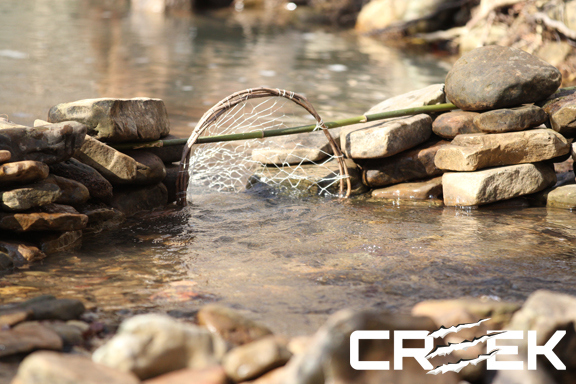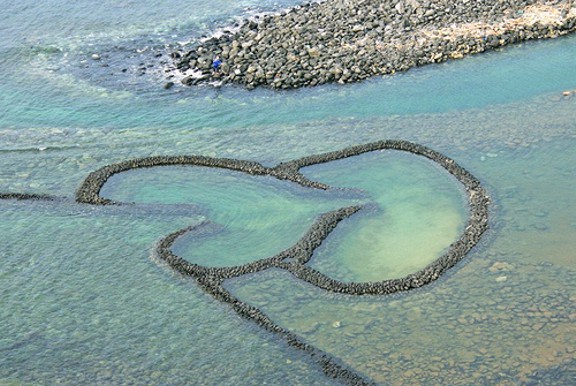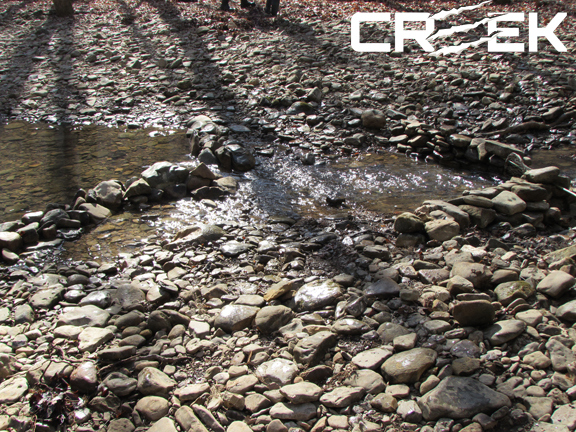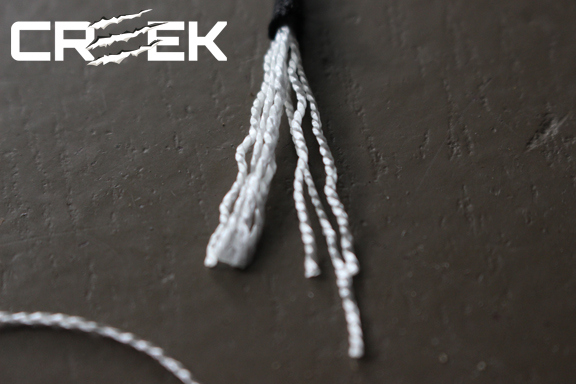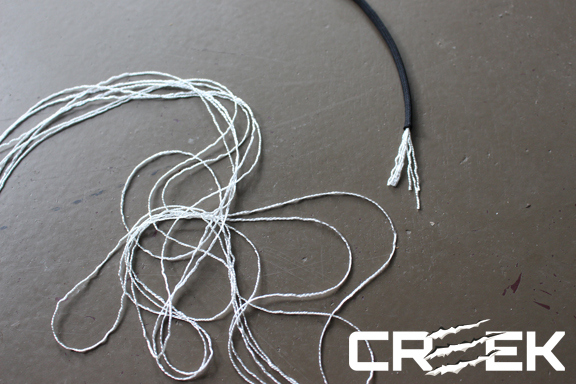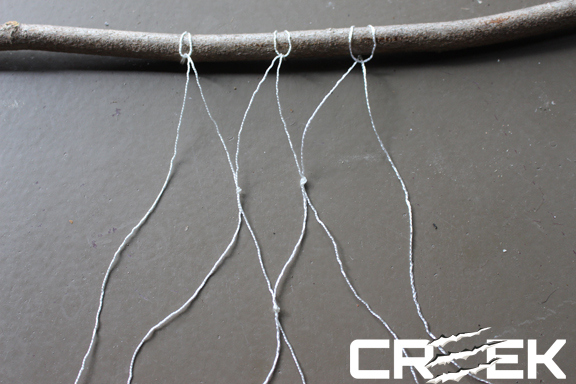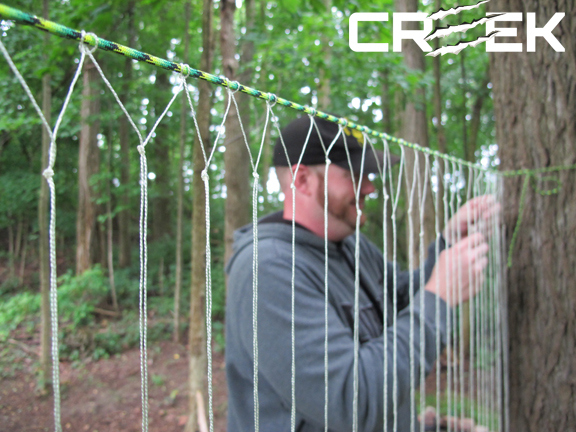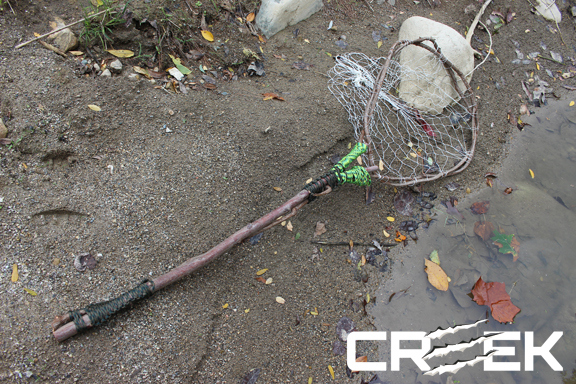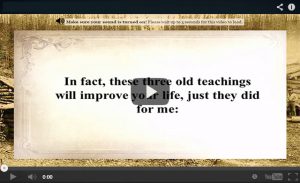One of my favorite skills of the entire 1st Season of FAT GUYS IN THE WOODS was when Zach, Opie, Joe and I made a paracord survival net and used it in conjunction with a hand built rock weir to catch fish in a Tennessee river valley.
Methods of catching fish similar to this have been around for centuries so I take no credit for the concept. In fact, remnants of stone fishing weirs still exist all over the world today. A “WEIR” is simply a word that mean an obstruction in the water to help guide the fish where you want them.
Below is a well preserved ancient stone weir in China (more info here: http://en.wikipedia.org/wiki/Double-Heart_of_Stacked_Stones) Pretty awesome, right?
Below is a less extravagant Native American stone weir in Wabash County, IN. Stone weirs were literally used across the globe to funnel fish moving down stream into basket or nets, much like we did in the episode of FAT GUYS IN THE WOODS.
The Choke Point
Opie, Zach, Joe and I were able to find a perfect choke point in the river upstream from where we were camped to give this ancient time-tested method of catching fish an honest shot. The river formed a natural choke point that allowed us to build a double layer stone weir with only a few hours of hard labor. Stones were plentiful and readily available so it seemed like the perfect plan.
The Net
The plan was to funnel fish through the weir into a net – EXCEPT WE DIDN’T HAVE A NET. The most time consuming part of this process was hand weaving our own net from scratch. We did this using paracord. Paracord is awesome stuff. It has 7 inner stands that are perfect for net weaving. These inner strands can be effortlessly pulled from the outer sheath – called GUTTING paracord.
Once we ‘gutted’ some paracord, it was now time to start weaving the net. It’s not difficult, but it is time-consuming! We decided to make a circular shaped net that we could fit into the funnel portion of our weir. I made the frame by wrapping a stout and flexible vine around itself in a circular shape. I’ve made nets that are circular in shape and also ones that are long and flat. The long and flat ones are gill-net style nets that are meant to be stretched across a stream or river. These are much larger and more time consuming.
The knots I use are very simple. The first knot, called a Lark’s Head, fastens the paracord strands to the frame. You can see this knot in the photo below.
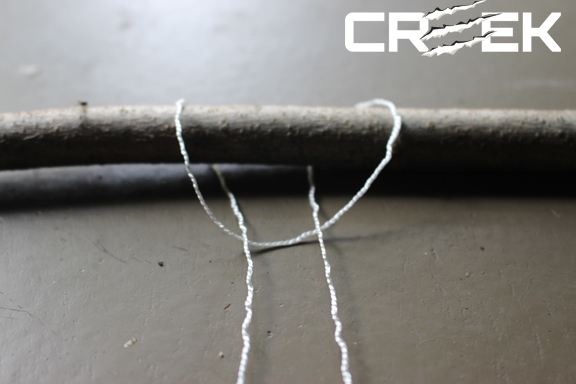 In the case of a circular dip net, these paracord strands are tied all the way around the frame about 1″ apart. Below is a photo showing 3 strands fastened using a Lark’s Head knot.
In the case of a circular dip net, these paracord strands are tied all the way around the frame about 1″ apart. Below is a photo showing 3 strands fastened using a Lark’s Head knot.
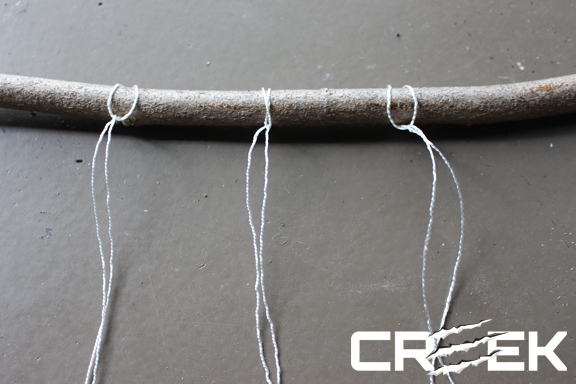 The next step is to tie (using a simple granny overhand knot) the inner strand of one hanging pair to the inner strand of the neighboring hanging pair and do this all the way around the frame.
The next step is to tie (using a simple granny overhand knot) the inner strand of one hanging pair to the inner strand of the neighboring hanging pair and do this all the way around the frame.
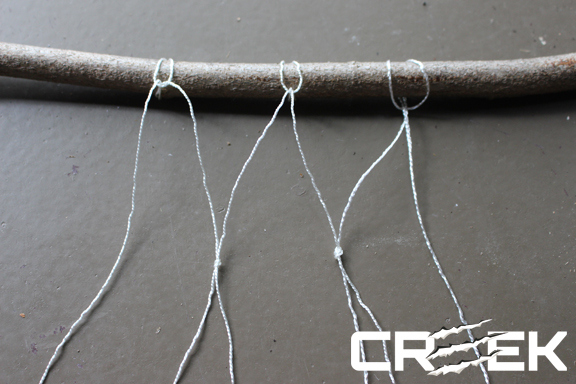 Once an entire circle has been made all the way around the frame you can move to the next row of knots, then the 3rd, etc…
Once an entire circle has been made all the way around the frame you can move to the next row of knots, then the 3rd, etc…
Below are some photos from one of my courses at Willow Haven Outdoor of students making both circular dip nets and flat gill nets. These photos really help to illustrate the stages of net making.
Below, Lisa is working on her second row of overhand knots.
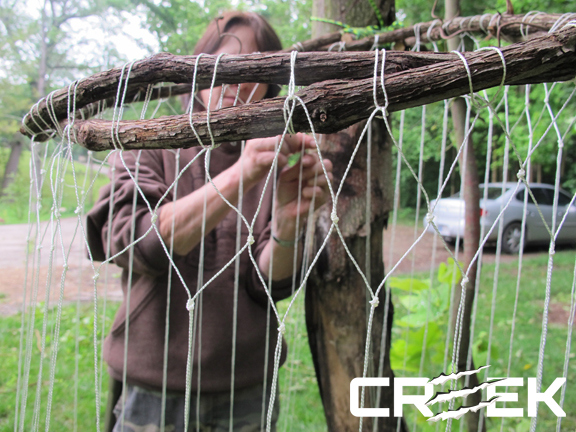 Below, Justin starts the 3rd row of a very ambitious gill net project!
Below, Justin starts the 3rd row of a very ambitious gill net project!
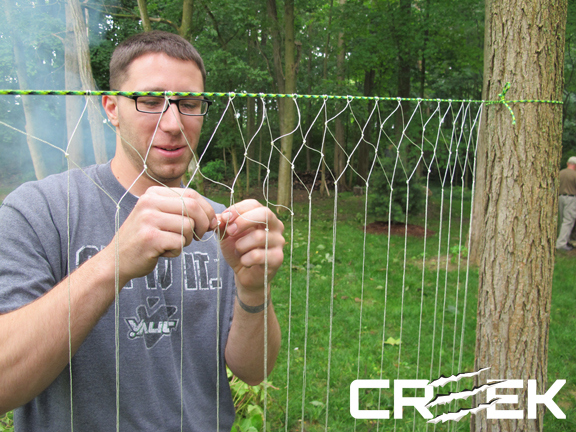 Kevin just finished his first row on his gill net.
Kevin just finished his first row on his gill net.
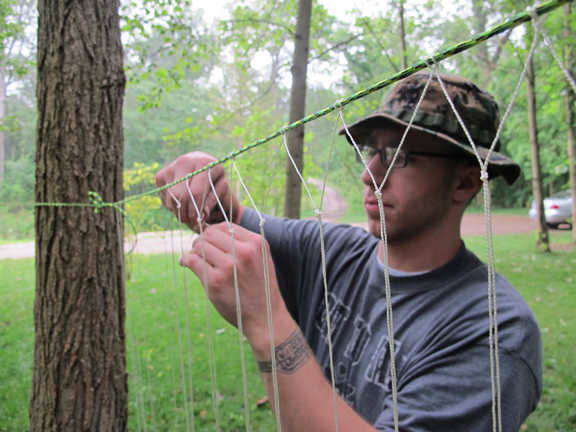 Lisa, just finishing the 1st step of tying all the strands on with Lark’s Head knots.
Lisa, just finishing the 1st step of tying all the strands on with Lark’s Head knots.
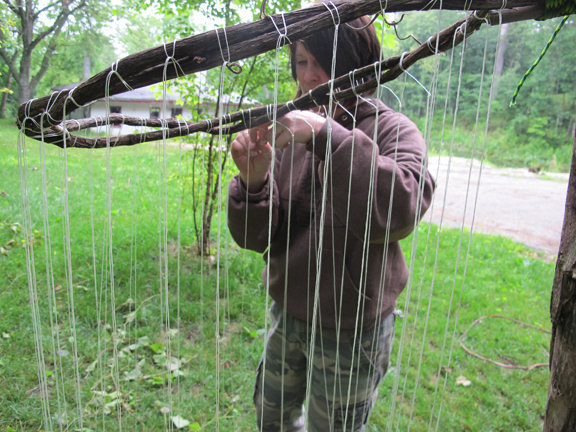 Lisa, working her way around with overhand knots.
Lisa, working her way around with overhand knots.
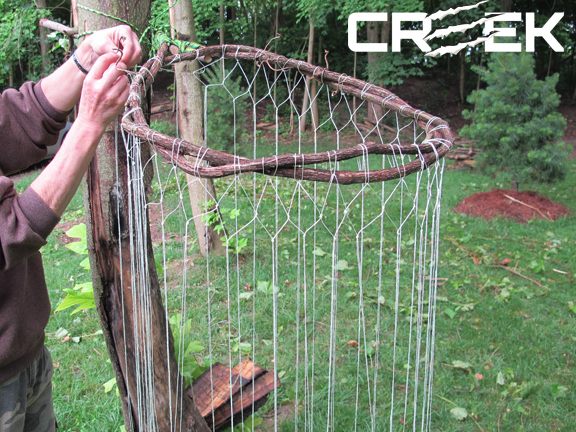 Lisa in the photos above made an awesome handled dip net that she left behind at Willow Haven. (Lisa – I’m still hanging onto it your you !!!!) Below are a couple photos of her finished dip net.
Lisa in the photos above made an awesome handled dip net that she left behind at Willow Haven. (Lisa – I’m still hanging onto it your you !!!!) Below are a couple photos of her finished dip net.
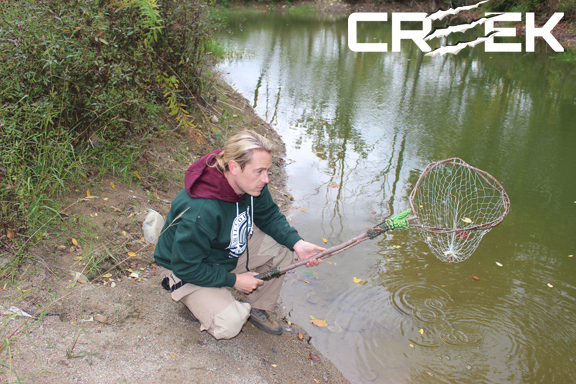 Here’s a shot of me working on our net during FAT GUYS IN THE WOODS. Patience is NOT my best virtue and this skill is certainly an exercise in PATIENCE and DETAIL work. Notice how we have suspended the net frame with paracord so that we can work all the way around while it is hanging.
Here’s a shot of me working on our net during FAT GUYS IN THE WOODS. Patience is NOT my best virtue and this skill is certainly an exercise in PATIENCE and DETAIL work. Notice how we have suspended the net frame with paracord so that we can work all the way around while it is hanging.
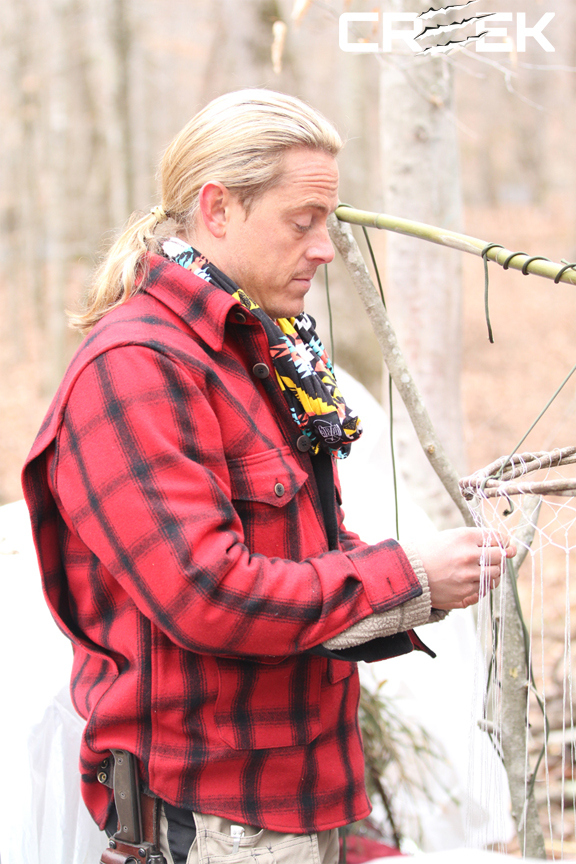 Below is a photo of Zach, Opie, Joe and I stacking our double layer stone weir. Notice how each weir funnels the fish exactly where we want them to go in a DOWNSTREAM direction.
Below is a photo of Zach, Opie, Joe and I stacking our double layer stone weir. Notice how each weir funnels the fish exactly where we want them to go in a DOWNSTREAM direction.
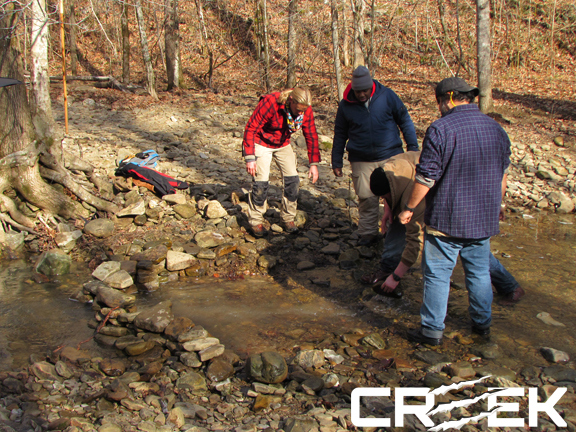 Below is a photo of the finished system for you to study. The first weir is basically an insurance policy. Only the 2nd weir has a net at the choke point.
Below is a photo of the finished system for you to study. The first weir is basically an insurance policy. Only the 2nd weir has a net at the choke point.
CONCLUSION
Hopefully these extra detailed photos and descriptions make this skill easier to understand and practice at home. Like I said earlier, it’s not difficult but it is time consuming. Expect to spend several hours weaving a dip net like we did on the show. If you’re like me, you’ll be tempted to rush. Resist the urge, as the quality of the net will suffer if you do.

